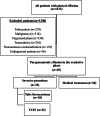The role of corticosteroids in preventing invasive procedures in patients with parapneumonic effusion in the exudative phase: An observational study
- PMID: 39287265
- PMCID: PMC11404972
- DOI: 10.1097/MD.0000000000039693
The role of corticosteroids in preventing invasive procedures in patients with parapneumonic effusion in the exudative phase: An observational study
Abstract
The aim of the study was investigate the effect of corticosteroid use on the need for invasive procedure like tube thoracostomy with underwater seal drainage (TT-UWSD) and Video Assisted Thoracoscopic Surgery (VATS) in adult patients diagnosed with parapneumonic effussion in the exudative phase. A retrospective cohort study was performed in a chest diseases hospital. A total of 65 patients were included in the study. While 30 patients received only medical treatment, 35 patients underwent invasive procedures. Data on characteristics, vital signs, and laboratory parameters were recorded from electronic medical records. Univariate and multivariate logistic regression analyses were performed to identify corticosteroid and other predictors of the need for invasive procedures. The outcomes of the multivariate regression analysis revealed that an longer duration of symptoms (OR = 1.10, 95% CI: 1.01-1.21, P < .033) and the presence of dyspnea (OR = 5.44, 95% CI: 1.26-23.50, P < .023) independently associated with an increased need for invasive procedures, while corticosteroid treatment (OR = 0.15, 95% CI: 0.02-0.81, P < .028) was observed to be associated with a reduced necessity for invasive procedures. Treatment with metilprednisolone, together with the absence of dyspnea and shorter symptom duration may independently decrease the need for invasive procedure in patients with parapneumonic pleural effusion in the exudative phase.
Copyright © 2024 the Author(s). Published by Wolters Kluwer Health, Inc.
Conflict of interest statement
All authors have no conflicts of interest to declare.
Similar articles
-
Therapy of parapneumonic effusions in children: video-assisted thoracoscopic surgery versus conventional thoracostomy drainage.Pediatrics. 2006 Sep;118(3):e547-53. doi: 10.1542/peds.2005-2719. Epub 2006 Aug 14. Pediatrics. 2006. PMID: 16908618 Clinical Trial.
-
Comparative analysis of chest tube thoracostomy and video-assisted thoracoscopic surgery in empyema and parapneumonic effusion associated with pneumonia in children.Surg Infect (Larchmt). 2008 Jun;9(3):317-23. doi: 10.1089/sur.2007.025. Surg Infect (Larchmt). 2008. PMID: 18570573
-
Video-assisted thoracoscopic surgery in the treatment of complicated parapneumonic effusions or empyemas: outcome of 234 patients.Chest. 2005 Apr;127(4):1427-32. doi: 10.1378/chest.127.4.1427. Chest. 2005. PMID: 15821225
-
Medical and surgical treatment of parapneumonic effusions : an evidence-based guideline.Chest. 2000 Oct;118(4):1158-71. doi: 10.1378/chest.118.4.1158. Chest. 2000. PMID: 11035692 Review.
-
Is video-assisted thoracoscopic surgery the best treatment for paediatric pleural empyema?Interact Cardiovasc Thorac Surg. 2011 Jul;13(1):70-6. doi: 10.1510/icvts.2010.254698. Epub 2011 Mar 30. Interact Cardiovasc Thorac Surg. 2011. PMID: 21454312 Review.
References
-
- Light RW, Girard WM, Jenkinson SG, George RB. Parapneumonic effusions. Am J Med. 1980;69:507–12. - PubMed
-
- Koegelenberg CF, Diacon AH, Bolliger CT. Parapneumonic pleural effusion and empyema. Respiration. 2008;75:241–50. - PubMed
-
- Singh S, Singh SK, Tentu AK. Management of parapneumonic effusion and empyema. J Assoc Chest Physicians. 2019;7:51–8.
-
- Ferguson AD, Prescott RJ, Selkon JB, Watson D, Swinburn CR. The clinical course and management of thoracic empyema. QJM. 1996;89:285–9. - PubMed
-
- Nasreen N, Mohammed KA, Hardwick J, et al. . Polar production of interleukin-8 by mesothelial cells promotes the transmesothelial migration of neutrophils: role of intercellular adhesion molecule-1. J Infect Dis. 2001;183:1638–45. - PubMed
Publication types
MeSH terms
Substances
LinkOut - more resources
Full Text Sources
Medical


